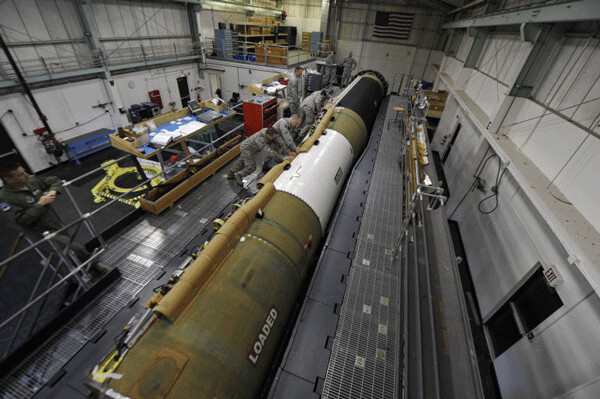News & Articles
Browse all content by date.

While the rest of the world pursues the abolition of nuclear weapons - amazingly foretold by the adoption July 7 of the Treaty on the Prohibition of Nuclear Weapons, or the Nuclear Weapon Ban Treaty - the thoroughly militarized Trump White House is avidly pursuing plans for a trillion-dollar rebuild of the US entire nuclear weapons complex. The massive replacement proposal is designed to eventually produce 80 new nuclear warheads every year, including three new warhead types, a new bomber-launched nuclear-armed Cruise missile (called the Long Range Stand Off), a new B61 nuclear gravity bomb, and a new intercontinental ballistic missile.
Emergency relief and humanitarian aid for floods, hurricanes, earthquakes, famines, pandemics, and refugees can be damned it seems. Budgets for health, education and human welfare programs all need to be trimmed because, as WallStreet.com online reported recently that, “A review by the Arms Control Association, a nonpartisan, nuclear weapons watchdog, [found] the total 30-year cost of the program could rise to $1.5 trillion” - $500 billion beyond what the Obama Administration first proposed in 2016.
It must be that the urgent need for global problem solving can be addressed with guns since Trump’s White House Chief of Staff is Marine Corps General James Kelly. Trump’s National Security Advisor is former Army Lieutenant General HR McMaster. And Trump’s Secretary of Defense is Marine Corps General James, “Mad Dog,” Mattis, who only quit the Marines in 2013 and serves in violation of a “waived” federal law barring military officers from becoming Pentagon Chief for 7 years after retiring.
Confronting climate and warzone disasters head-on Aug. 8, the Department of Energy and US Air Force conducted two tests of the proposed B61-12 gravity bomb at Tonopah Test Range in Nevada. The unarmed test bomb drop - from an F-15E Strike Eagle, which the Air Force uses currently in wars in Iraq, Afghanistan, Syria, and Libya -- demonstrated the jet’s ability to wage nuclear war. The $12 billion B61-12 program “is progressing on schedule,” said Phil Calbos, the Acting Deputy Administrator of the National Nuclear Security Administration (NNSA) which builds and maintains US nuclear warheads. Calbos graduated from the Military Academy at West Point and used to be an infantry officer.
The B61 bomb test involved new “tailfin” hardware designed by Boeing Corporation, headquartered in Chicago. NNSA wants the first usable B61-12 bomb to be finished in 2022 and intends to ship 180 of them to five “nuclear sharing” NATO partner states in Europe, replacing the ones already there. Never mind that German, Dutch, and Belgian politicians have all called for permanent removal of the US nuclear bombs, and the Air Force itself may soon remove them from Turkey. Another 400 to 600 new B61s are being planned for replacing the B61s now used on long-range B-52 and B-1 bombers.
On Aug. 21, the Air Force granted $349 million in contracts to Boeing, and $329 to Northrop Grumman and put the two giant weapons contractors into competition to replace the current arsenal of 450 Minuteman III intercontinental ballistic missiles. Popular Mechanics reports that “Northrop Grumman and Boeing each have been awarded just under $350 million to churn out Technology Maturation and Risk Reduction (TMRR) studies before the Air Force picks a single winner.” One of the two contractors is expected to win the $100 billion contract to build the brand new ICBMs, known as the Ground Based Strategic Deterrent.
This push for a replacement ICBM flies in the face of high-level calls for an end to land-based missiles. In January 2015, Gen. Mattis told the Senate Armed Services Committee, “You should ask, ‘Is it time to reduce the triad to a diad, removing the land-based missiles?’” Speaking Dec. 3, 2015, former Secretary of Defense William Perry, who headed the Pentagon under President Bill Clinton, called for retiring land-based intercontinental ballistic missiles altogether saying, “ICBMs aren’t necessary … they’re not needed. Any reasonable definition of deterrence will not require that third leg.” (The other “legs” are submarines and long-range bombers.)
In 2012, a blue-ribbon commission chaired by Gen. James Cartwright, a former Vice Chairman of the Joint Chiefs of Staff and a former commander of US nuclear forces, called for eliminating the ICBM system. Later, at a 2012 Senate hearing, Gen. Cartwright testified that the ICBMs could be retired without leaving the US at risk. Cartwright’s commission report, which was signed by Senator and soon-to-be Defense Secretary Chuck Hagel, concluded that “a US nuclear weapons arsenal with none left on ICBMs was big enough.”
Don’t be fooled by Congressional pleas for “austerity,” fiscal responsibility, and “we can’t afford it” budget cutting unless these useless weapons programs - soon-to-be prohibited by a UN treaty - are cut first.
| Tweet |

